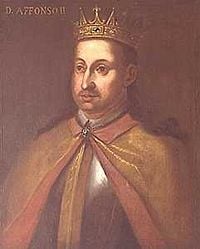Afonso II
| Afonso II | ||
|---|---|---|
| King of Portugal | ||

| ||
| Seventeenth century painting of Afonso II. | ||
| Reign | March 26, 1212âMarch 25, 1223 | |
| Full name | Afonso Sanches of Portugal | |
| Titles | Infante of Portugal (1185â1212) | |
| Born | April 23, 1185 | |
| Coimbra, Kingdom of Portugal | ||
| Died | March 25, 1223 | |
| Coimbra, Kingdom of Portugal | ||
| Buried | Santa Cruz Monastery, Coimbra, District of Coimbra, Portugal | |
| Predecessor | Sancho I of Portugal | |
| Heirs | Infante Sancho (future Sancho II) (1212â1223) | |
| Successor | Sancho II of Portugal | |
| Consort | Infanta Urraca of Castile | |
| Issue | Infante Sancho (future Sancho II) (1207â1248) Infante Afonso (1210â1279) Infanta Leonor, Queen of Denmark (1211â1231) Infante Fernando, Lord of Serpa (a. 1217âc. 1243) Infante Vicente (1219) | |
| Royal House | Capetian House of Burgundy | |
| Father | Sancho I of Portugal | |
| Mother | Dulce Berenguer of Barcelona, Infanta of Aragon | |
Afonso II, King of Portugal (Portuguese pron. IPA /É'fĂľsu/; English Alphonzo), or Affonso (Archaic Portuguese), Alfonso or Alphonso (Portuguese-Galician) or Alphonsus (Latin version), nicknamed "the Fat" (Portueguese o Gordo), third king of Portugal, was born in Coimbra on April 23, 1185 and died on March 25, 1223 in the same city. He was the second but eldest surviving son of Sancho I of Portugal by his wife, Dulce Berenguer of Barcelona, Infanta of Aragon. Afonso succeeded his father in 1212. Afonso's father gave a generous patrimony to the Church, so much in fact the monarchy inherited by Afonso II was almost impoverished. Afonso established a commission to look into the issue of land title and required feudal lords to apply for letters of confirmation. In the process the commission discovered many abuses â borders had been illegally extended and the correct taxes were not being paid, at considerable cost to the crown. It is interesting to note, the commission did not seek evidence from the aristocrats but from local people. Afonso II may well have set out primarily to restore his own fortunes but in the process he also challenged the wealth, and possibly the priorities, of the Church.
| Afonso Henriques (Afonso I) |
|---|
|
| Sancho I |
|
| Afonso II |
|
| Sancho II |
| Afonso III |
|
| Denis |
|
| Afonso IV |
|
| Peter I |
|
| Ferdinand I |
|
| Beatrice (disputed queen) |
|
Kingship
As a king, Afonso II set a different approach of government. His father, Sancho I, and his grandfather Afonso I, were mostly concerned with military issues either against the neighboring Kingdom of Castile or against the Moorish lands in the south. Afonso did not pursue territory enlargement policies and managed to insure peace with Castile during his reign. Despite this, some towns, like AlcĂĄcer do Sal in 1217, were conquered from the Moors by the private initiative of noblemen. No inference is meant to convey that he was a weak or somehow cowardly man. The first years of his reign were marked by internal disturbances between Afonso and his brothers and sisters. As king he managed to keep security within Portuguese borders only by outlawing and exiling his kin.
Because military issues were not a government priority, Afonso established the state's administration and centralized power on himself. He designed the first set of Portuguese written laws. These were mainly concerned with private property, civil justice, and minting. Afonso also sent ambassadors to European kingdoms outside the Iberian Peninsula and began amiable commercial relations with most of them.
Other reforms instituted by Alfonso I included the always delicate matters with the pope. In order to get the independence of Portugal recognized by Rome, his grandfather, Afonso I legislated enormous privileges to the Church. These boons eventually created a state within the state. With Portugal's position as a country firmly established, Afonso II endeavored to weaken the power of the clergy and to apply a portion of the enormous revenues of the Roman Catholic church to purposes of national utility. These actions led to a serious diplomatic conflict between Rome and Portugal. After being excommunicated for his perceived audacities by Pope Honorius III, Afonso II promised to make amends to the church, but he died in 1223 before making any serious attempts to do so.
Legacy
Afonso II was the third king of Portugal, ruling from 1211 to 1231. In addition to pursuing the reconquest of the South from the Moors, he is best remembered for challenging the Church over land rights. Afonso II may well have set out primarily to restore his own fortunes but in the process he also challenged the wealth, and possibly the priorities, of the Roman Catholic Church. Alfonso II was not alone, there were others who criticized the wealth and privileges of the church and they, like Afonso, were excommunicated for their views. Alfonso viewed temporal power, wealth, and the secularization of the medieval church as contrary to God's will. As much as Afonso II may have created an opportunity for the Roman Catholic Church in Portugal to rethink its priorities, he died before the restitution Rome commanded was paid.
Ancestors
| Afonso II of Portugal | Father: Sancho I of Portugal |
Father's father: Afonso I of Portugal |
Father's father's father: Henry of Burgundy, Count of Portugal |
| Father's father's mother: Teresa of LeĂłn, Countess of Portugal | |||
| Father's mother: Maud of Savoy |
Father's mother's father: Amadeus III of Savoy | ||
| Father's mother's mother: Mahaut of Albon | |||
| Mother: Dulce Berenguer of Barcelona |
Mother's father: Ramon Berenguer IV, Count of Barcelona |
Mother's father's father: Ramon Berenguer III, Count of Barcelona | |
| Mother's father's mother: Douce of GĂŠvaudaun | |||
| Mother's mother: Petronila of Aragon |
Mother's mother's father: Ramiro II of Aragon | ||
| Mother's mother's mother: Agnes of Aquitaine |
Marriage and descendants
Afonso married Infanta Urraca of Castile, daughter of Alfonso VIII, King of Castile, and Leonora of Aquitaine, in 1208.
| Name | Birth | Death | Notes |
|---|---|---|---|
| By Urraca of Castile (1186-1220; married in 1208) | |||
| Infante Sancho | September 8, 1207 | January 4, 1248 | Succeeded him as Sancho II, 4th King of Portugal. |
| Infante Afonso | May 5, 1210 | February 16, 1279 | Succeeded his brother Sancho as Afonso III, 5th King of Portugal. |
| Infanta Leonor (Eleanor) | 1211 | 1231 | Married Prince Valdemar, son of Valdemar II of Denmark and Margaret of Bohemia, daughter of Ottokar I of Bohemia. |
| Infante Fernando | c. 1217 | c. 1243 | Lord of Serpa. |
| Vicente | 1219 | 1219 | Â |
| Natural offspring | |||
| JoĂŁo Afonso | ? | 1234 | Natural son. |
| Pedro Afonso | c. 1210 | ? | Natural son. |
ReferencesISBN links support NWE through referral fees
- Amaral, Diogo Freitas do. D. Afonso Henriques: biografia. Colecção Figuras de todos os tempos, 3. Lisboa: Bertrand Editora, 2000. ISBN 9722511572
- Anderson, James Maxwell. The History of Portugal. The Greenwood histories of the modern nations. Westport, Conn: Greenwood Press, 2000. ISBN 9780313311062
- Marques, Antonio Henrique R. de Oliveira. History of Portugal. New York: Columbia University Press, 1972. ISBN 9780231031592
- Mattoso, JosĂŠ. D. Afonso Henriques. Lisboa, Portugal: Circulo de Leitores, 2006. ISBN 9789724238678
- This article incorporates text from the EncyclopĂŚdia Britannica Eleventh Edition, a publication now in the public domain.
| House of Burgundy Cadet Branch of the Capetian dynasty Born: 23 April 1185;Â Died: 25 March 1223 | ||
|---|---|---|
|
| ||
| Preceded by: Sancho I |
King of Portugal 1211 â 1223 |
Succeeded by: Sancho II |
| ||||||||||||||||||||
Credits
New World Encyclopedia writers and editors rewrote and completed the Wikipedia article in accordance with New World Encyclopedia standards. This article abides by terms of the Creative Commons CC-by-sa 3.0 License (CC-by-sa), which may be used and disseminated with proper attribution. Credit is due under the terms of this license that can reference both the New World Encyclopedia contributors and the selfless volunteer contributors of the Wikimedia Foundation. To cite this article click here for a list of acceptable citing formats.The history of earlier contributions by wikipedians is accessible to researchers here:
The history of this article since it was imported to New World Encyclopedia:
Note: Some restrictions may apply to use of individual images which are separately licensed.
